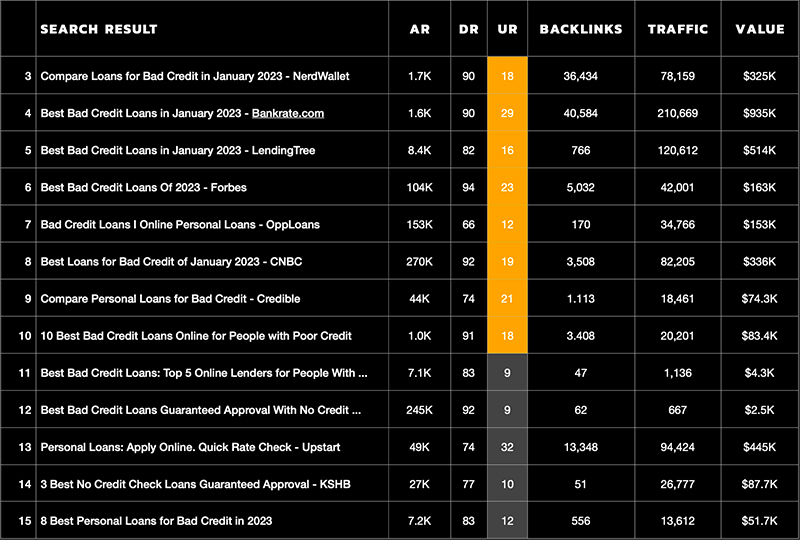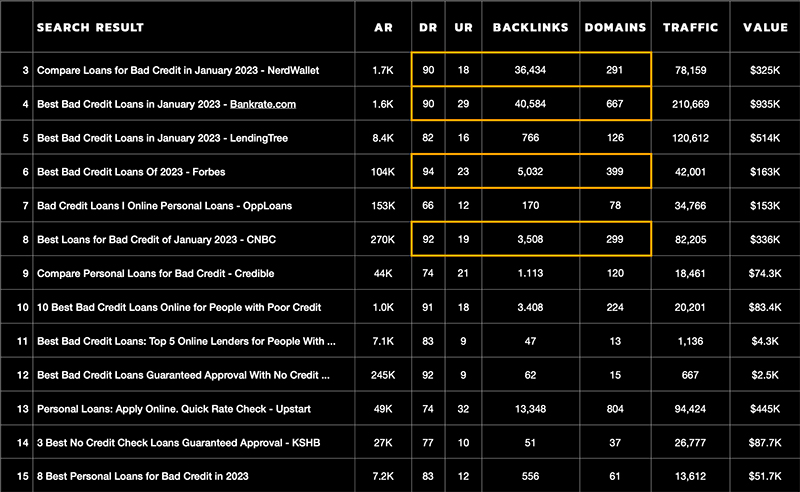Hyper-S Framework
Having access to data is great, but only if it can be turned into strategy and applied at scale. The Hyper-S Framework is how we apply our advantages to a given website.
POWER & AUTHORITY
We know that the algorithm favors strong, authoritative, and trustworthy websites, but how do we establish those qualities within your website so you catch Google’s eye?
Link-building.
Though it’s not rocket science, link-building is a grind – one your competitors are most likely shying away from. And in the zero-sum game of SEO, taking the hard road becomes a major competitive advantage. In other words, links are central to getting the results you’re looking for.
But to do that, we need to prove your power and authority at two distinct levels.
THE WEBSITE LEVEL
Your strength and authority at the website level are key in determining how likely you will rank in the SERPs. SearchTides’s preferred metric to track this authority is Domain Rating (DR). DR stands for domain rating, a 1-100 rating, logarithmic in nature, used to measure the strength of a given website based on the backlink profile of the website. If your competitors have a higher DR, it’s because they have a better link profile – and more referring domains (links) – pointing to their websites.
BRAND WEBSITE STRENGTH REFERRING DOMAINS TRAFFIC TRAFFIC VALUE
ULG DR 53 2,060 47.1K $19.8K
OL DR 66 7,050 389K $1.1M
ARG DR 69 9,110 269K $1.0M
BOA DR 88 92,000 28.7M $38M
BR DR 89 159,000 14.8M $65M
The more quality referring domains you have, the higher your DR and the greater your organic traffic. Link building makes your domain more authoritative and trustworthy. The only way to increase Website Strength is through link building. Links that point from one website to another, referring domains, lead to increases in organic traffic.
Link building increases referring domains, which leads to increases in organic traffic
Pharma:
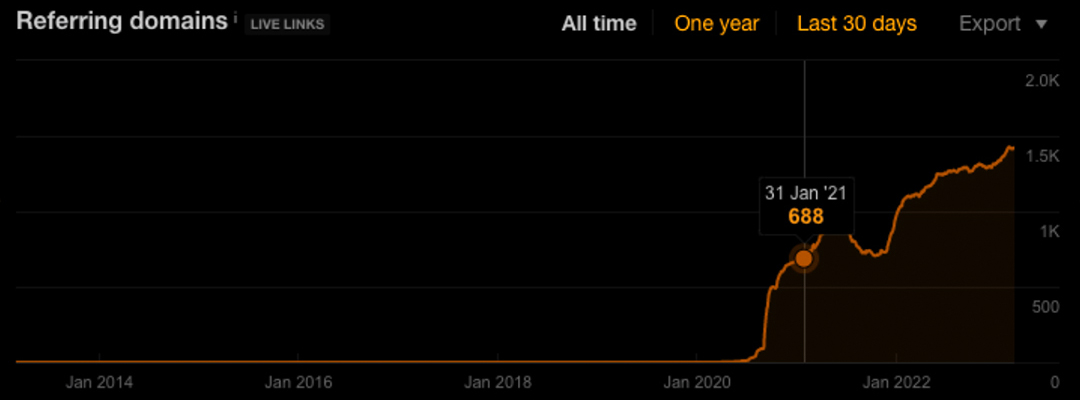
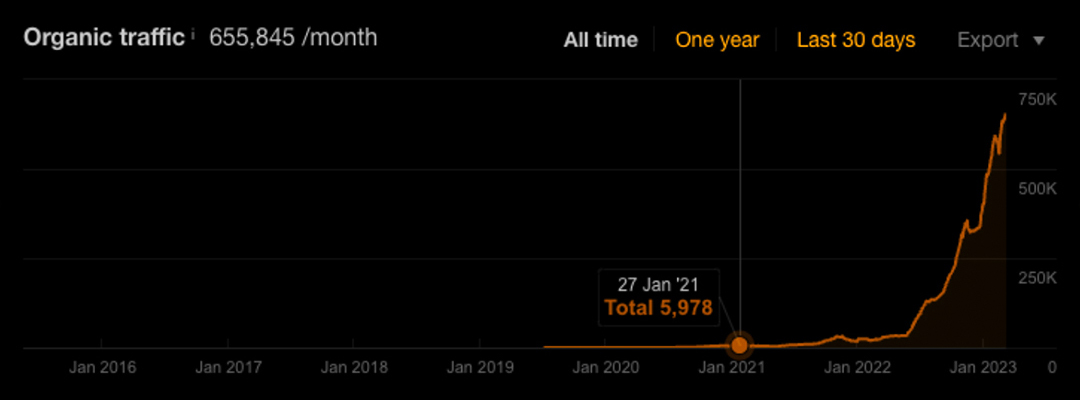
Fitness:
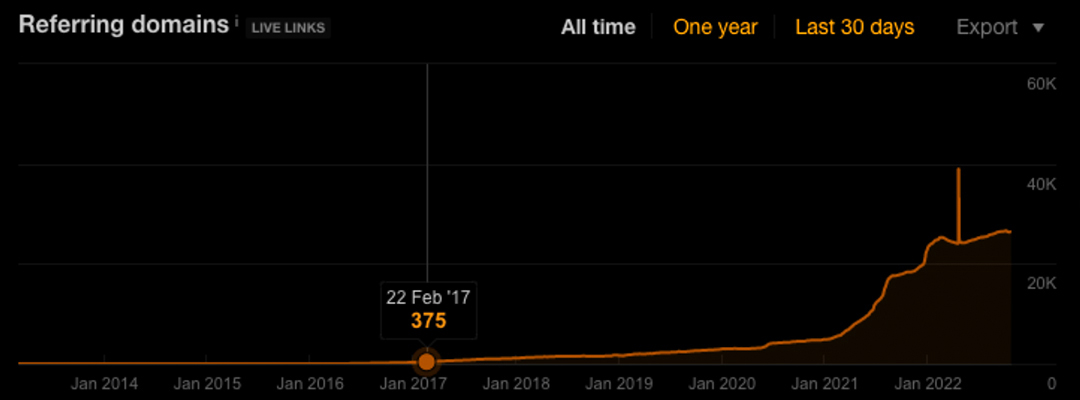
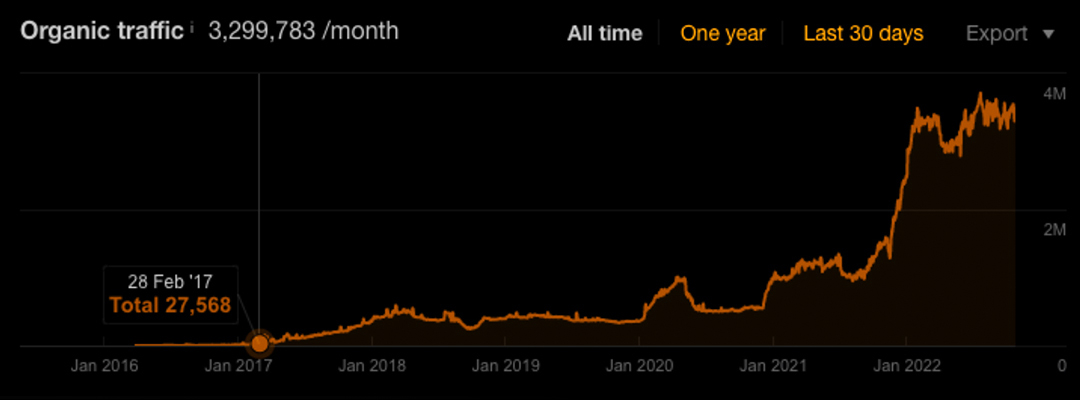
Fintech:
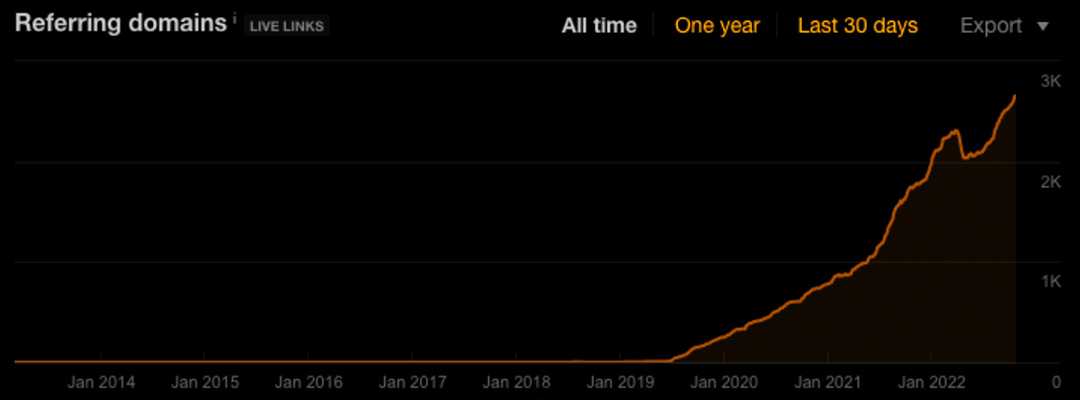
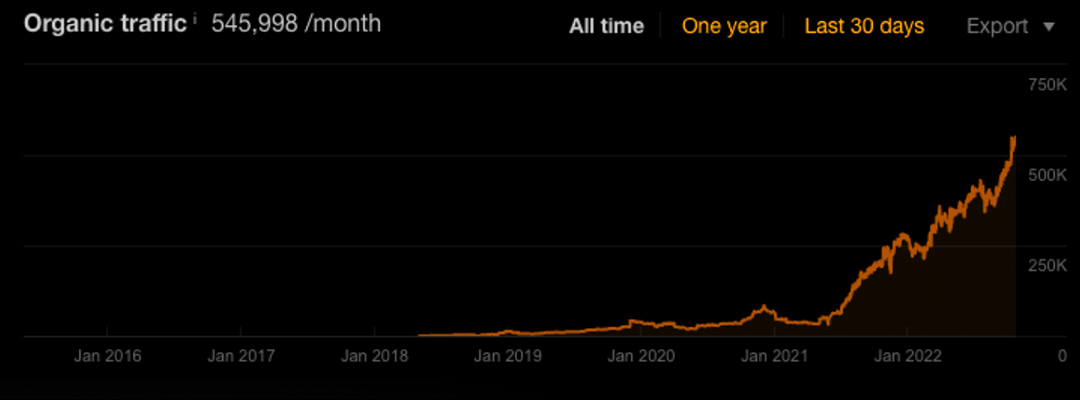
If it’s so easy… why doesn’t everyone do it?
- It’s an incredibly manual process.
- It’s very high volume and conversion rates are low.
- Grading the future prospects of a website are very challenging.
The bottom line: If your competition has a more authoritative website (higher DR), you need links to be apples-to-apples competitive.
Link building is the number one thing that companies avoid in SEO because it is hard. For this reason, over 2/3 of people at SearchTides are exclusively focused on link building.
THE PAGE LEVEL
Where your DR measures authority at the website level, your URL rating (UR) determines authority at the page level. This metric accounts for your DR and the power of referring domains pointing to a specific page.
Yes – a stronger DR will increase UR more quickly, but to maximize the competitive advantage available with link building, we’ll help you leapfrog authority at the page level. Because ultimately, pages are what rank.
| SEARCH RESULT | AR | DR | UR | BACKLINKS | TRAFFIC | VALUE | |
|---|---|---|---|---|---|---|---|
| 3 | Compare Loans for Bad Credit in January 2023 - NerdWallet | 1.7K | 90 | 18 | 36,434 | 78159 | $325K |
| 4 | Best Bad Credit Loans in January 2023 - Bankrate.com | 1.6K | 90 | 29 | 40,584 | 210669 | $935K |
| 5 | Best Bad Credit Loans in January 2023 - LendingTree | 8.4K | 82 | 16 | 766 | 120612 | $514K |
| 6 | Best Bad Credit Loans Of 2023 - Forbes | 104K | 94 | 23 | 5,032 | 42001 | $163K |
| 7 | Bad Credit Loans I Online Personal Loans - OppLoans | 153K | 66 | 12 | 170 | 34766 | $153K |
| 8 | Best Loans for Bad Credit of January 2023 - CNBC | 270K | 92 | 19 | 3,508 | 82205 | $336K |
| 9 | Compare Personal Loans for Bad Credit - Credible | 44K | 74 | 21 | 1 | 18461 | $74.3K |
| 10 | 10 Best Bad Credit Loans Online for People with Poor Credit | 1.0K | 91 | 18 | 3 | 20201 | $83.4K |
| 11 | Best Bad Credit Loans: Top 5 Online Lenders for People With ... | 7.1K | 83 | 9 | 47 | 1136 | $4.3K |
| 12 | Best Bad Credit Loans Guaranteed Approval With No Credit ... | 245K | 92 | 9 | 62 | 667 | $2.5K |
| 13 | Personal Loans: Apply Online. Quick Rate Check - Upstart | 49K | 74 | 32 | 13,348 | 94424 | $445K |
| 14 | 3 Best No Credit Check Loans Guaranteed Approval - KSHB | 27K | 77 | 10 | 51 | 26777 | $87.7K |
| 15 | 8 Best Personal Loans for Bad Credit in 2023 | 7.2K | 83 | 12 | 556 | 13612 | $51.7K |
In the photo below, there are four websites with a similar DR. For each page, the greater the amount of referring domains, the higher the UR.
| SEARCH RESULT | AR | DR | UR | BACKLINKS | DOMAINS | TRAFFIC | VALUE | |
|---|---|---|---|---|---|---|---|---|
| 3 | Compare Loans for Bad Credit in January 2023 - NerdWallet | 1.7K | 90 | 18 | 36,434 | 291 | 78159 | $325K |
| 4 | Best Bad Credit Loans in January 2023 - Bankrate.com | 1.6K | 90 | 29 | 40,584 | 667 | 210669 | $935K |
| 5 | Best Bad Credit Loans in January 2023 - LendingTree | 8.4K | 82 | 16 | 766 | 126 | 120612 | $514K |
| 6 | Best Bad Credit Loans Of 2023 - Forbes | 104K | 94 | 23 | 5,032 | 399 | 42001 | $163K |
| 7 | Bad Credit Loans I Online Personal Loans - OppLoans | 153K | 66 | 12 | 170 | 78 | 34766 | $153K |
| 8 | Best Loans for Bad Credit of January 2023 - CNBC | 270K | 92 | 19 | 3,508 | 299 | 82205 | $336K |
| 9 | Compare Personal Loans for Bad Credit - Credible | 44K | 74 | 21 | 1 | 120 | 18461 | $74.3K |
| 10 | 10 Best Bad Credit Loans Online for People with Poor Credit | 1.0K | 91 | 18 | 3 | 224 | 20201 | $83.4K |
| 11 | Best Bad Credit Loans: Top 5 Online Lenders for People With ... | 7.1K | 83 | 9 | 47 | 13 | 1136 | $4.3K |
| 12 | Best Bad Credit Loans Guaranteed Approval With No Credit ... | 245K | 92 | 9 | 62 | 15 | 667 | $2.5K |
| 13 | Personal Loans: Apply Online. Quick Rate Check - Upstart | 49K | 74 | 32 | 13,348 | 804 | 94424 | $445K |
| 14 | 3 Best No Credit Check Loans Guaranteed Approval - KSHB | 27K | 77 | 10 | 51 | 37 | 26777 | $87.7K |
| 15 | 8 Best Personal Loans for Bad Credit in 2023 | 7.2K | 83 | 12 | 556 | 61 | 13612 | $51.7K |
THE BOTTOM LINE WITH LINK BUILDING
To garner more authority with Google, you need more powerful links pointing to your website and its core pages.
Lower authority at the website level? You need links.
Lower authority at the page level? You need links.
And if your rankings look peachy on paper, remember that doing nothing compared to your competitors can send them soaring to the top of the SERPs.
You need links – period. We’ve never seen a campaign where links were not critical to success.
That’s why we’ve put so much focus on delivering high-quality links at scale. It’s hard, but we do the grind. You get to own the SERPs in no time.
ORGANIC ASSETS
There are many models for assessing the “depth” of a website. And when it comes to content, most people think bigger is better.
The more pages, the better. The more content, the better.
Right?
Not quite.
If you have a 10,000-page website, and only 100 generate quality traffic, you have a 100-page website and 9,900 pages of problems. When Google wastes its budget crawling those less-than-valuable pages, it causes more harm than good.
What website depth actually comes down to is not bigger is better. It’s not even quality over quantity. It’s quantity of quality.
HOW WE DEFINE, ASSESS, AND INCREASE ORGANIC ASSETS
We define organic assets as the number of pages bringing you meaningful, non-branded traffic. In other words, we create a more accurate assessment of your website depth because we focus on the number of pages that are working for you.
Here’s how we rank industry winners:
- Take the top 1k keywords for a given sub-industry.
- Identify the pages generating meaningful traffic.
- Identify how frequently they’re showing up across that keyword set.
Once we have a ranking of domains with the greatest number of assets, we go one step further. We’ll calculate the traffic going to each of those assets, determine the value of a page, and ultimately the value of a website’s total organic assets.
HERE’S HOW WE CAN INCREASE YOUR NUMBER OF ORGANIC ASSETS:
Content Creation
We use methodologies like topic clustering and SERP similarity to create content on a sufficient amount of sub-topics.
On-Site Optimization
We use correlation modeling from thousands of ranking factors to give your pages the extra boosts they need.
Interlinking
We can direct internal power to specific pages and combine them with entity callouts to highlight assets.
Link Building
We increase the authority of a given page through links so it can generate more site traffic.
TECHNOLOGY & RENDERING
Technical SEO is one of the most misunderstood sub-categories of SEO. It can mean everything from adding an H2 on the page, to optimizing page speed and selecting the best CMS. In our experience, a small, small fraction of technical SEO is actually worth focusing on.
We categorize technical issues in one of two categories:
THE SMALL STUFF
Maybe there’s a bug on your website that’s messing up Google’s crawling ability and hurting your budget. Maybe you need more H2s (and quite a few conversations with product/devs). Either way, these are technical issues that can be solved with a quick fix so they shouldn’t be heavily factored into a long-term analysis of your website.
THE BIG-PICTURE STUFF
On the other hand, maybe you have a larger tech stack decision that someone made a case for (across multiple departments) as the best, most viable solution. Any sort of changes to decisions like these would require time, focus, and an admission of the wrong choice. These big-picture technical issues are inherently tied to the core expression of your website and will require massive changes to solve.
The Big-picture Stuff includes things like:
- Rendering solutions
- Frameworks
- CMS
To further illustrate this point, consider this: The most technically optimized page in Google’s eyes is one of static HTML and CSS. How much has your website deviated from that setup?
Some food for thought.
“GOOD” VS “BAD” TECHNOLOGY
Having a “technically optimal” page isn’t feasible – and frankly, doesn’t make sense – for most brands. But when you’re constantly implementing technologies, stacks, and solutions on top of that base layer, you enter a precarious game of trying not to “mess things up.”
When “good” technology is implemented incorrectly – and based on someone from Product’s understanding of SEO – you’ve got problems.
When “good” technology is implemented correctly – and based on a holistic understanding of SEO – you’ll see zero negative impact. That’s the SearchTides criteria for “good” technology. And it turns out, those “good” technologies correlate massively with your site’s rankings.
Correlating Factor Measurement with Rank Position in Google

| Correlation | Samples | Coefficient | Critical Value | Significance | Was Significant |
|---|---|---|---|---|---|
| Spearman’s | 96 | -0.44 | 0.20 | 95% | true |
| Pearson’s | 96 | -0.39 | 0.20 | 95% | true |
Having a Spearman’s Coefficient of -0.44 and Pearson’s Coefficient of -0.39 are actually massively significant. Our threshold at SearchTides for “incredibly meaningful” is anything less than -0.20.
As for “bad” technologies, they exist – *cough* rendering solutions *cough*.
Correlating Factor Measurement with Rank Position in Google
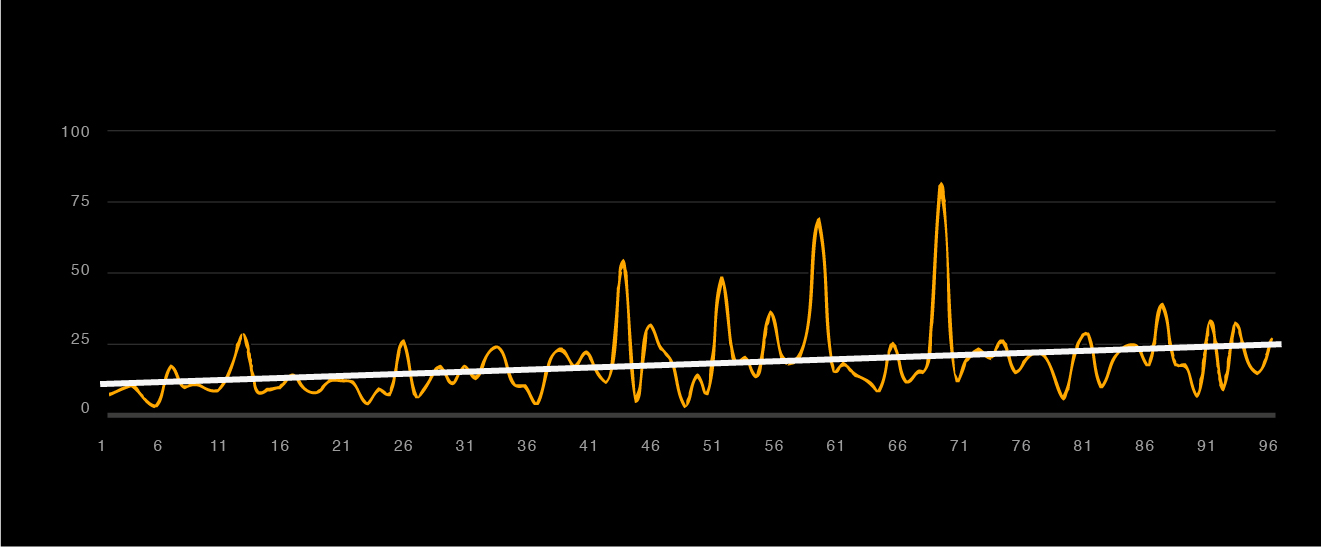
Correlation Samples Coefficient
Spearman’s 96 0.47
Pearson’s 96 0.34
We can see that the greater the number of “bad” technologies (represented by the Y axis of Factor Measurement) on a given domain, the worse overall rankings are.
Even with a phenomenal team that’s implemented everything properly, “bad” tech will rear its ugly head.
So how do we solve these big-picture issues? Data-informed, big-picture solutions.
We have first-rate access to critical data that can turn a high-stakes game of hodgepodge solutions into informed technical structures that positively impact your SEO – on a major scale.
BRAND SEARCH
One of the more meaningful components of “brand” as it pertains to SEO is brand search – a search in Google where one of the words used is the name of a brand. Although some say a pure brand search needs every word in the search to be the brand, we’re a bit of a mixed breed.
Let’s use Geico as an example:
- “Geico” is a brand search.
- “Geico insurance” is a brand + keyword search.
These are the two main layers that SEOs think about, but there’s a layer below – brand + keyword search at the product level.
Here’s an example:
- Geico home insurance
- Car insurance by Geico
- Auto insurance Geico
Here we see different products (home/car), as well as different ways of describing the same product (car/auto). And of course, it goes much deeper than that:
- Car insurance Geico
- Does Geico offer insurance for my home?
- What happens if I die Geico
These are the components of brand search. They’re more complex than what some typically associate with “brand,” because this is how people actually search online.
HOW BRAND SEARCH AND NON-BRANDED TRAFFIC EFFECT EACH OTHER
There are two things you need to know:
- Ranking for good keywords with commercial intent leads to more brand search.
- Brand search leads to more non-branded search, and thus, more non-branded traffic.
What we’re highlighting here is that the research process of a product or service investigation leads to more branded traffic, simply because non-branded rankings exist. Here’s an example of this in action:
A Tale Of Brand Search
The year is 2017 and Jessie needs renter’s insurance. He types that into Google and is met with a flurry of recognizable brand names and one he doesn’t recognize: Lemonade. Jessie visits their site, clicks around for a bit, but doesn’t buy.
Later, when Jessie comes back to the insurance search, he can’t for the life of him remember the name of the brand. He types “rental insurance fruit” into Google. The results show pages of people talking about a “hot new startup that is disrupting the insurance game, but they aren’t actually selling you $0.10 drinks from a corner stand.”
“Ahh, that’s right, it’s Lemonade,” thinks Jessie. He searches “lemonade insurance” and gets tossed into Google. The rest is history.
BRAND SEARCH LEADS TO MORE NON-BRANDED TRAFFIC?
It does! If you’d like more details as to why, feel free to contact us, as this is going outside of what makes sense to discuss in public.
Similarly, if your brand has a brand search issue, it can be increased without deploying massive advertising budgets.
If brand search is your missing piece of the puzzle, that’s something SearchTides can help you fix.
POWER & AUTHORITY
We know that the algorithm favors strong, authoritative, and trustworthy websites, but how do we establish those qualities within your website so you catch Google’s eye?
Link-building.
Though it’s not rocket science, link-building is a grind – one your competitors are most likely shying away from. And in the zero-sum game of SEO, taking the hard road becomes a major competitive advantage. In other words, links are central to getting the results you’re looking for.
But to do that, we need to prove your power and authority at two distinct levels.
THE WEBSITE LEVEL
Your strength and authority at the website level are key in determining how likely you will rank in the SERPs. SearchTides’s preferred metric to track this authority is Domain Rating (DR). DR stands for domain rating, a 1-100 rating, logarithmic in nature, used to measure the strength of a given website based on the backlink profile of the website. If your competitors have a higher DR, it’s because they have a better link profile – and more referring domains (links) – pointing to their websites.
The more quality referring domains you have, the higher your DR and the greater your organic traffic. Link building makes your domain more authoritative and trustworthy. The only way to increase Website Strength is through link building. Links that point from one website to another, referring domains, lead to increases in organic traffic.
Link building increases referring domains, which leads to increases in organic traffic
Pharma:
Fitness:
Fintech:

If it’s so easy… why doesn’t everyone do it?
- It’s an incredibly manual process.
- It’s very high volume and conversion rates are low.
- Grading the future prospects of a website are very challenging.
The bottom line: If your competition has a more authoritative website (higher DR), you need links to be apples-to-apples competitive.
Link building is the number one thing that companies avoid in SEO because it is hard. For this reason, over 2/3 of people at SearchTides are exclusively focused on link building.
THE PAGE LEVEL
Where your DR measures authority at the website level, your URL rating (UR) determines authority at the page level. This metric accounts for your DR and the power of referring domains pointing to a specific page.
Yes – a stronger DR will increase UR more quickly, but to maximize the competitive advantage available with link building, we’ll help you leapfrog authority at the page level. Because ultimately, pages are what rank.
In the photo below, there are four websites with a similar DR. For each page, the greater the amount of referring domains, the higher the UR.
THE BOTTOM LINE WITH LINK BUILDING
To garner more authority with Google, you need more powerful links pointing to your website and its core pages.
Lower authority at the website level? You need links.
Lower authority at the page level? You need links.
And if your rankings look peachy on paper, remember that doing nothing compared to your competitors can send them soaring to the top of the SERPs.
You need links – period. We’ve never seen a campaign where links were not critical to success.
That’s why we’ve put so much focus on delivering high-quality links at scale. It’s hard, but we do the grind. You get to own the SERPs in no time.
ORGANIC ASSETS
There are many models for assessing the “depth” of a website. And when it comes to content, most people think bigger is better.
The more pages, the better. The more content, the better.
Right?
Not quite.
If you have a 10,000-page website, and only 100 generate quality traffic, you have a 100-page website and 9,900 pages of problems. When Google wastes its budget crawling those less-than-valuable pages, it causes more harm than good.
What website depth actually comes down to is not bigger is better. It’s not even quality over quantity. It’s quantity of quality.
HOW WE DEFINE, ASSESS, AND INCREASE ORGANIC ASSETS
We define organic assets as the number of pages bringing you meaningful, non-branded traffic. In other words, we create a more accurate assessment of your website depth because we focus on the number of pages that are working for you.
Here’s how we rank industry winners:
- Take the top 1k keywords for a given sub-industry.
- Identify the pages generating meaningful traffic.
- Identify how frequently they’re showing up across that keyword set.
Once we have a ranking of domains with the greatest number of assets, we go one step further. We’ll calculate the traffic going to each of those assets, determine the value of a page, and ultimately the value of a website’s total organic assets.
HERE’S HOW WE CAN INCREASE YOUR NUMBER OF ORGANIC ASSETS:
Content Creation
We use methodologies like topic clustering and SERP similarity to create content on a sufficient amount of sub-topics.
On-Site Optimization
We use correlation modeling from thousands of ranking factors to give your pages the extra boosts they need.
Interlinking
We can direct internal power to specific pages and combine them with entity callouts to highlight assets.
Link Building
We increase the authority of a given page through links so it can generate more site traffic.
TECHNOLOGY & RENDERING
Technical SEO is one of the most misunderstood sub-categories of SEO. It can mean everything from adding an H2 on the page, to optimizing page speed and selecting the best CMS. In our experience, a small, small fraction of technical SEO is actually worth focusing on.
We categorize technical issues in one of two categories:
THE SMALL STUFF
Maybe there’s a bug on your website that’s messing up Google’s crawling ability and hurting your budget. Maybe you need more H2s (and quite a few conversations with product/devs). Either way, these are technical issues that can be solved with a quick fix so they shouldn’t be heavily factored into a long-term analysis of your website.
THE BIG-PICTURE STUFF
On the other hand, maybe you have a larger tech stack decision that someone made a case for (across multiple departments) as the best, most viable solution. Any sort of changes to decisions like these would require time, focus, and an admission of the wrong choice. These big-picture technical issues are inherently tied to the core expression of your website and will require massive changes to solve.
The Big-picture Stuff includes things like:
- Rendering solutions
- Frameworks
- CMS
To further illustrate this point, consider this: The most technically optimized page in Google’s eyes is one of static HTML and CSS. How much has your website deviated from that setup?
Some food for thought.
“GOOD” VS “BAD” TECHNOLOGY
Having a “technically optimal” page isn’t feasible – and frankly, doesn’t make sense – for most brands. But when you’re constantly implementing technologies, stacks, and solutions on top of that base layer, you enter a precarious game of trying not to “mess things up.”
When “good” technology is implemented incorrectly – and based on someone from Product’s understanding of SEO – you’ve got problems.
When “good” technology is implemented correctly – and based on a holistic understanding of SEO – you’ll see zero negative impact. That’s the SearchTides criteria for “good” technology. And it turns out, those “good” technologies correlate massively with your site’s rankings.
Correlating Factor Measurement with Rank Position in Google
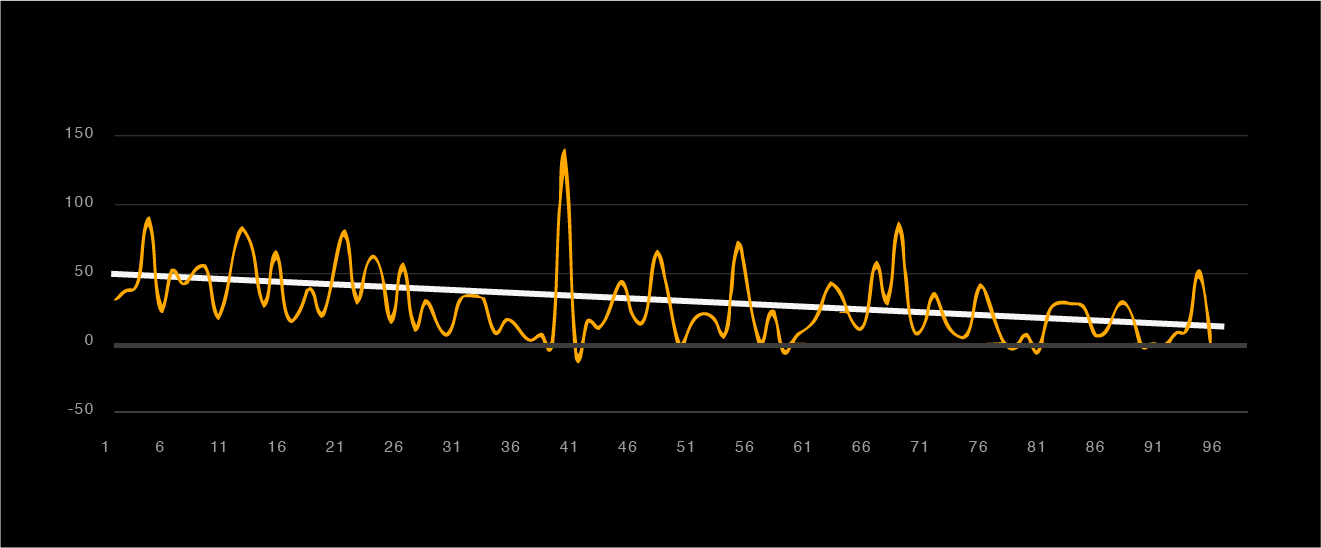
| Correlation | Samples | Coefficient | Critical Value | Significance | Was Significant |
|---|---|---|---|---|---|
| Spearman’s | 96 | -0.44 | 0.20 | 95% | true |
| Pearson’s | 96 | -0.39 | 0.20 | 95% | true |
Having a Spearman’s Coefficient of -0.44 and Pearson’s Coefficient of -0.39 are actually massively significant. Our threshold at SearchTides for “incredibly meaningful” is anything less than -0.20.
As for “bad” technologies, they exist – *cough* rendering solutions *cough*.
Correlating Factor Measurement with Rank Position in Google

Correlation Samples Coefficient
Spearman’s 96 0.47
Pearson’s 96 0.34
We can see that the greater the number of “bad” technologies (represented by the Y axis of Factor Measurement) on a given domain, the worse overall rankings are.
Even with a phenomenal team that’s implemented everything properly, “bad” tech will rear its ugly head.
So how do we solve these big-picture issues? Data-informed, big-picture solutions.
We have first-rate access to critical data that can turn a high-stakes game of hodgepodge solutions into informed technical structures that positively impact your SEO – on a major scale.
BRAND SEARCH
One of the more meaningful components of “brand” as it pertains to SEO is brand search – a search in Google where one of the words used is the name of a brand. Although some say a pure brand search needs every word in the search to be the brand, we’re a bit of a mixed breed.
Let’s use Geico as an example:
- “Geico” is a brand search.
- “Geico insurance” is a brand + keyword search.
These are the two main layers that SEOs think about, but there’s a layer below – brand + keyword search at the product level.
Here’s an example:
- Geico home insurance
- Car insurance by Geico
- Auto insurance Geico
Here we see different products (home/car), as well as different ways of describing the same product (car/auto). And of course, it goes much deeper than that:
- Car insurance Geico
- Does Geico offer insurance for my home?
- What happens if I die Geico
These are the components of brand search. They’re more complex than what some typically associate with “brand,” because this is how people actually search online.
HOW BRAND SEARCH AND NON-BRANDED TRAFFIC EFFECT EACH OTHER
There are two things you need to know:
- Ranking for good keywords with commercial intent leads to more brand search.
- Brand search leads to more non-branded search and thus, more non-branded traffic.
What we’re highlighting here is that the research process of a product or service investigation leads to more branded traffic simply because non-branded rankings exist. Here’s an example of this in action:
A Tale Of Brand Search
The year is 2017, and Jessie needs renter’s insurance. He types that into Google and is met with a flurry of recognizable brand names and one he doesn’t recognize: Lemonade. Jessie visits their site, clicks around for a bit, but doesn’t buy.
Later, when Jessie comes back to the insurance search, he can’t for the life of him remember the name of the brand. He types “rental insurance fruit” into Google. The results show pages of people talking about a “hot new startup that is disrupting the insurance game, but they aren’t actually selling you $0.10 drinks from a corner stand.”
“Ahh, that’s right, it’s Lemonade,” thinks Jessie. He searches “lemonade insurance” and gets tossed into Google. The rest is history.
BRAND SEARCH LEADS TO MORE NON-BRANDED TRAFFIC?
It does! If you’d like more details as to why, feel free to contact us, as this is going outside of what makes sense to discuss in public.
Similarly, if your brand has a brand search issue, it can be increased without deploying massive advertising budgets.
If brand search is your missing piece of the puzzle, that’s something SearchTides can help you fix.
Client experience
A Proven Framework For
Achieving Greatness
If you only want to dip your toes in the water, we're probably not a good fit for each other. On the other hand, if you're ready to become the dominant player in your space, it's time to chat.








